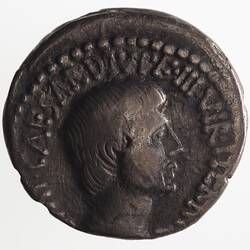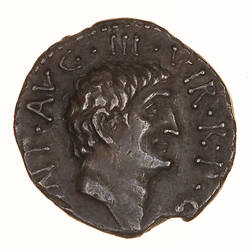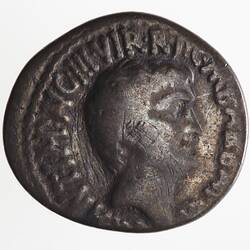Summary
Denarius, issued by Ancient Roman Republic, 36 BC
Imperatorial Period
Issuing Authority: IMP. CAESAR DIVI F. IIIVIR R.P.C (Octavian)
Minted by Moving with Octavian
Obverse Description
Head of Octavian facing right; around, IMP. CAESAR DIVI F. III. VIR. ITER R.P.C
Reverse Description
Tetrastyle temple with standing veiled figure (statue of deified Julius Caesar) at centre; on architrave, DIVO IVL; within pediment, a six-pointed star or comet; to left of temple, a lighted altar; around, COS ITER. ET TER. DESIG
Edge Description
Plain
Significance
The revesre of this coin depicts the temple to the divine Julius Caesar with his statue, as Augur inside and the sidus Iulium (Caesar's comet) on the pediment. The temple was still being built when the coin was issued and formed an important component of Octavian's political propaganda. Octavian was the nephew of Julius Caesar. The occurance of a comet, visible even in daylight, shortly after the asassination was seen as evidence that Julius Caesar had become a god. Ovid writing about 2 AD proclaims: Then Jupiter, the Father, spoke..."Take up Caesar's spirit from his murdered corpse, and change it into a star, so that the deified Julius may always look down from his high temple on our Capitol and forum." He had barely finished, when gentle Venus stood in the midst of the Senate, seen by no one, and took up the newly freed spirit of her Caesar from his body, and preventing it from vanishing into the air, carried it towards the glorious stars. As she carried it, she felt it glow and take fire, and loosed it from her breast: it climbed higher than the moon, and drawing behind it a fiery tail, shone as a star." (Metamorphoses; XV; 745-842)
More Information
-
Collecting Areas
-
Acquisition Information
Transfer from National Gallery of Victoria (NGV), C I Branch, 15 Mar 1976
-
Date Issued
36 BC
-
Issued By
-
Person Depicted
Emperor Augustus, Ancient Roman Republic, 36 BC
Issued as Octavian, prior to becomming Augustus, the first Emperor of Rome -
Person Depicted
Julius Caesar, 36 BC
Depicted as a deified statue inside the temple. -
Denomination
-
Material
Silver
-
Axis
07
-
Classification
-
Category
-
Discipline
-
Type of item
-
Object Dimensions
2 mm (Height), 18 mm (Outside Diameter), 2.492 g (Weight)
-
Shape
Off round
-
References
Crawford 540/2
[Book] Crawford, Michael H. 1974. Roman Republican Coinage., 537-538 & 743 Pages
[Book] Crawford, Michael H. 1985. Coinage & Money under the Roman Republic., 249 Pages





